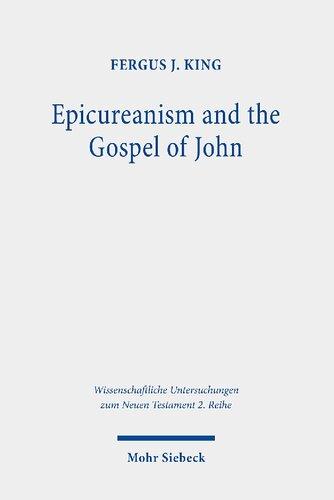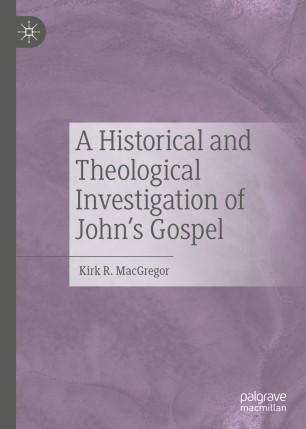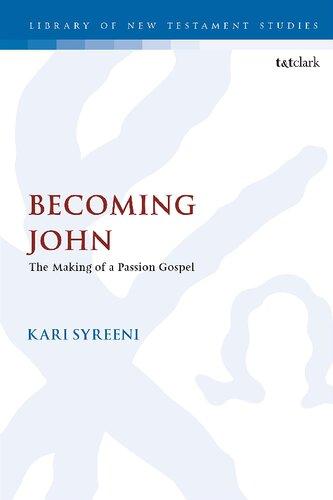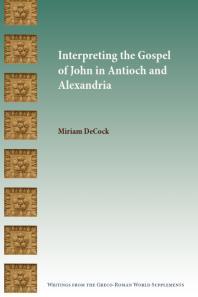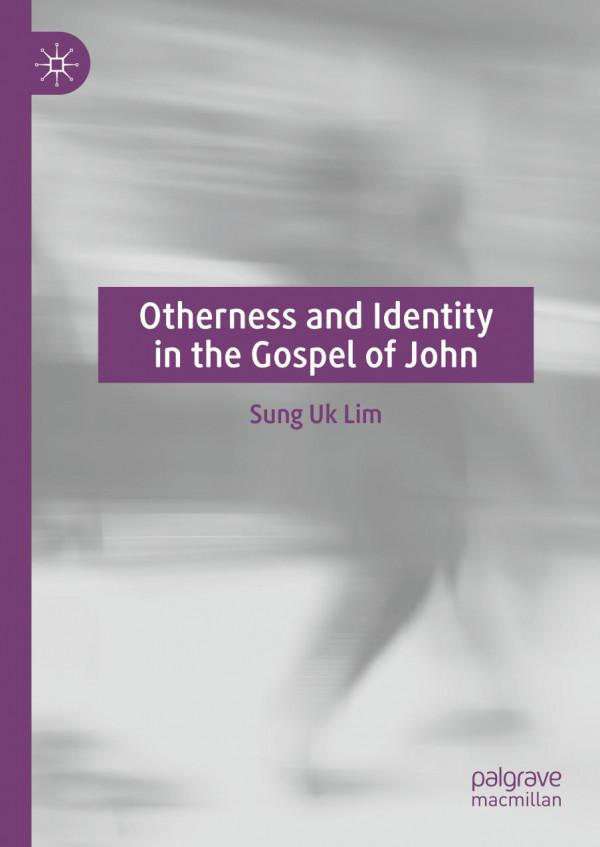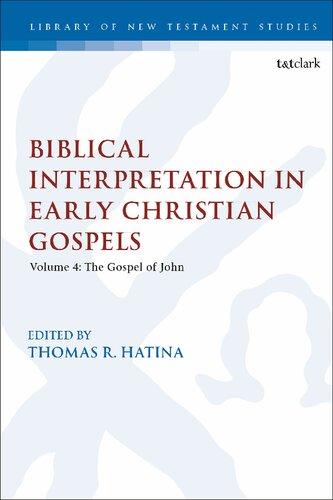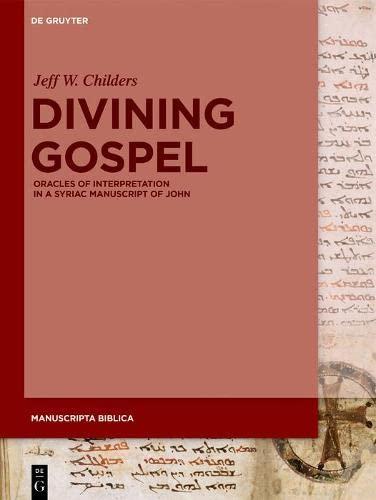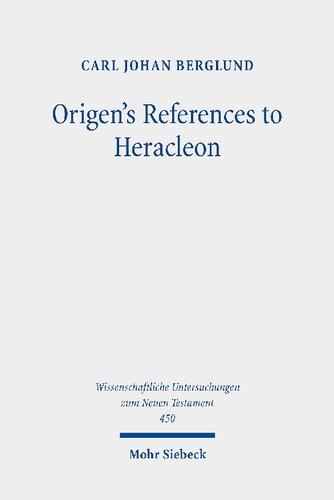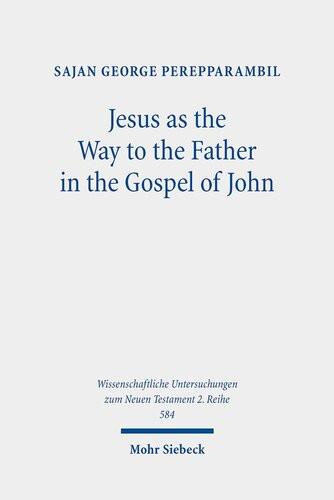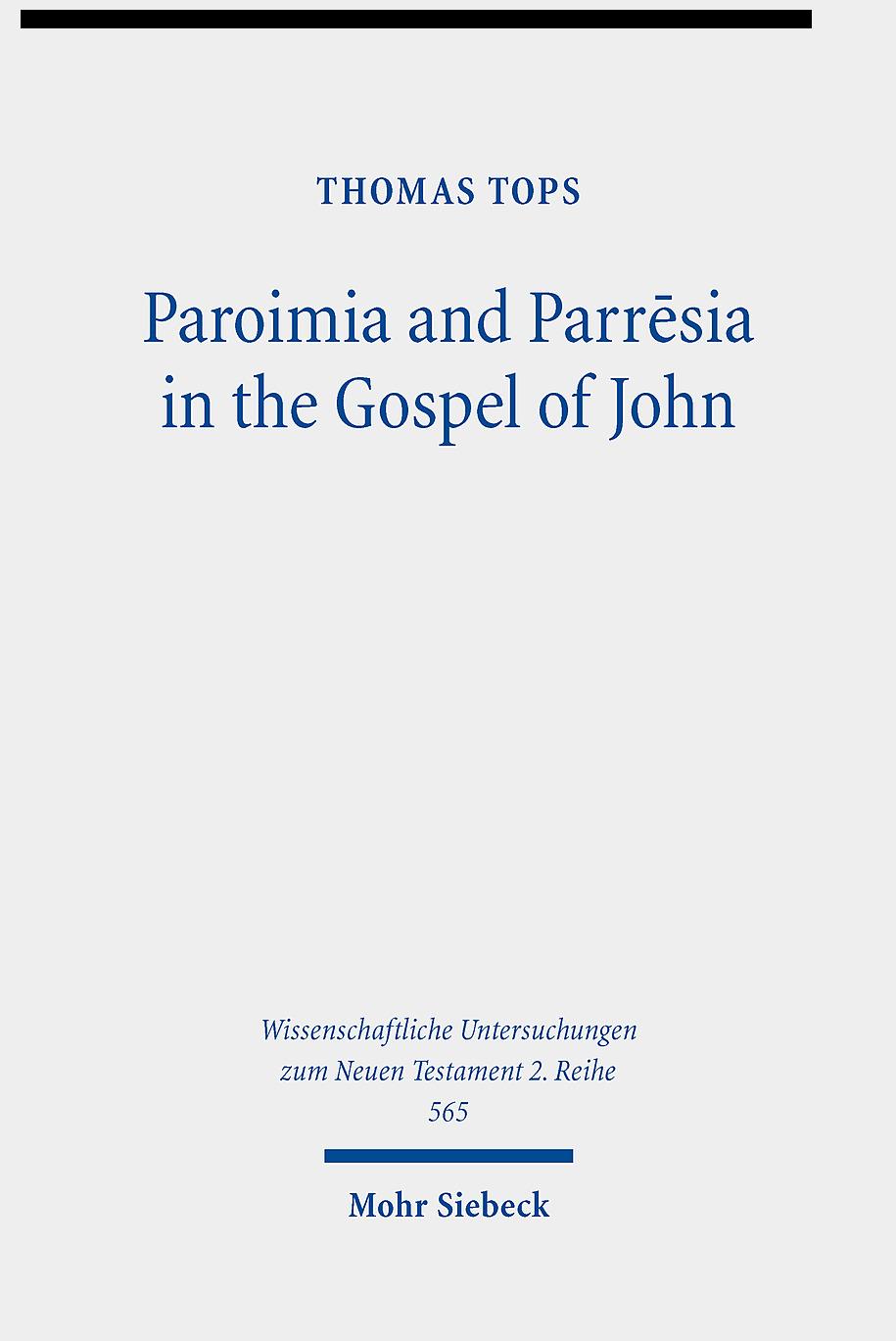Paroimia and Parrēsia in the Gospel of John
A Historical-Hermeneutical Study
Mohr Siebeck
Thomas Tops, born 1988; studied philosophy, theology, and classics, University of Antwerp and KU Leuven; 2017 21 PhD project, PThU Groningen and KU Leuven; since 2021 post-doctoral research fellow at the Centre for Advanced Studies “Beyond Canon,” University of Regensburg, Germany. orcid.org/0000-0002-4399-7045
ISBN 978-3-16-161102-5 / eISBN 978-3-16-161314-2
DOI 10.1628/978-3-16-161314-2
ISSN 0340-9570 / eISSN 2568-7484
(Wissenschaftliche Untersuchungen zum Neuen Testament, 2. Reihe)
The Deutsche Nationalbibliothek lists this publication in the Deutsche Nationalbibliographie; detailed bibliographic data are available at http://dnb.dnb.de
© 2022 Mohr Siebeck Tübingen, Germany. www.mohrsiebeck.com
This book may not be reproduced, in whole or in part, in any form (beyond that permitted by copyright law) without the publisher’s written permission. This applies particularly to reproductions, translations and storage and processing in electronic systems.
The book was printed on non-aging paper by Laupp & Göbel in Gomaringen, and bound by Buchbinderei Nädele in Nehren.
Printed in Germany.
5.1 Johannine and the Cosmological Tale (A. Reinhartz) .........................................................................................
5.2 Johannine and Participation/Transformation (G.R. O’Day and R. Kysar) ........................................................................
5.3 Johannine and Mark 4:1–20 (C.W. Skinner) ..................
6. Studies on the Semantics of Johannine
6.1 Johannine as Specifically Christian
6.2 An Initial Attempt to Historical Contextualisation of Johannine (G.L. Parsenios)............................................................
3.
3.1
3.2
3.3
1.1
1.2
2.
2.1
3.
2.2
3.1 Kierkegaard’s
3.2 The Paraclete’s
4.
3.
3.1
3.2
3.2.2
3.2.3
3.3
3.4
3.4.2
5.
2.1
2.
2.1
of
3.
Appendix 1: M š l in the Hebrew Bible and Its Translation Equivalents in the LXX and the Early Jewish Revisers
Appendix 2: Lists of Johannine
Appendix 3: Carson’s List of Literary Features of the Johannine Misunderstand ings.....................................................................................
Preface
This monograph presents my doctoral dissertation defended at the Protestant Theological University (PThU) of Groningen/Amsterdam on 11 June 2021 ( judicium : cum laude) with some minor adjustments. From April 2017 until April 2021 I worked on a Joint PhD project at the PThU Groningen and KU Leuven under the supervision of Prof. Dr. Annette Merz (PThU) and Prof. Dr. Reimund Bieringer (KU Leuven). I would like to express my deepest gratitude for the guidance and encouragements that I received from my two supervisors. I greatly benefitted from their comments and suggestions regarding the content, style, and structure of my dissertation. It was a pleasure to work with them. Along with my supervisors, I would like to thank Prof. em. Dr. Gilbert Van Belle, from whom I have learned too much to enumerate here.
In addition to my supervisors, I thank the following persons for having commented on texts that have led to this monograph: Dr. Robert Evans (University of Chester, UK), Prof. Dr. Arie Zwiep (VU Amsterdam, Netherlands), Prof. Dr. Hector Patmore (KU Leuven, Belgium), and Prof. Dr. Kristin De Troyer (University of Salzburg, Austria). I also thank Paul Creevey for having corrected the English of my text.
Special thanks go to Prof. Dr. John Fitzgerald, under whose supervision I worked at Notre Dame University in June 2018 and from 10 November to 10 December 2019. His comments on my writings greatly helped me to develop my thoughts on in ancient literature and the Gospel of John in particular.
Words of gratitude are also directed to the PThU, who have funded the four years of my doctoral research. I will always be in debt to this institution for having provided me with this opportunity.
I thank Prof. Dr. Jörg Frey and the associate editors of WUNT II for publishing my dissertation in this prestigious series. My appreciation also goes to the editorial team of Mohr Siebeck, who helped me prepare the manuscript for publication.
Finally, I am grateful for the support and love of my girlfriend, family, and friends. They were essential to me in the process of writing this monograph.
Abbreviations and Used Editions
For biblical writings, I make use of Nestle-Aland 28, the Biblia Hebraica Stuttgartensia, and the Göttingen edition of the LXX.1 For the LXX writings of which there is presently no Göttingen edition (e.g., Proverbs), I am obliged to consult Rahlfs’ edition.2 Translations of biblical texts are my own, if not indicated otherwise. For ancient non-biblical writings, I have, as a rule, in the first quotation mentioned the edition I quote from. If I provide a translation, I either refer to the translator in footnote or mention that it is my translation, or a translation that is adapted by me. The reader can find the full references of the translations in the bibliography.
The abbreviations of journals, major reference works, and series used in this monograph are taken from the SBL Handbook of Style.3 For the abbreviations of the names of ancient authors and their writings (including biblical) I have used the SBL Handbook of Style, Liddell – Scott – Jones, and Lampe.4 In some rare occasions, these reference works did not offer the required abbreviations, or the abbreviations offered were difficult to understand for an uninformed reader. I then used the abbreviations provided by the Franz Joseph Dölger Institut.5
The following abbreviations were used that cannot be found in the abovementioned reference works:
1 Karl Elliger et al. (eds.), Biblia Hebraica Stuttgartensia (Stuttgart: Deutsche Bibelgesellschaft, 51997); Barbara Aland et al. (eds.), Novum Testamentum Graece (Stuttgart: Deutsche Bibelgesellschaft, 282012); Joseph Ziegler et al. (eds.), Septuaginta: Vetus Testamentum Graecum. Auctoritate Academiae Scientiarum Gottingensis editum, 16 Bände (Göttingen: Vandenhoeck & Ruprecht, 1926–2015).
2 Alfred Rahlfs (ed.), Septuaginta: Id est Vetus Testamentum Graece iuxta LXX interpretes (Stuttgart: Deutsche Bibelgesellschaft, 2006).
3 See Billie J. Collins/Bob Buller/John F. Kutsko (eds.), The SBL Handbook of Style: For Biblical Studies and Related Disciplines (Atlanta GA: SBL Press, 22014), 171–260.
4 See Geoffrey W.H. Lampe (ed.), A Patristic Greek Lexicon (Oxford: Clarendon, 1961), xi–xlv; Henry G. Liddell/Robert Scott/Henry S. Jones (eds.), A Greek-English Lexicon, 9th ed. with revised supplement (Oxford: Clarendon, 1996), xvi–xxxviii; Collins/Buller/Kutsko (eds.), The SBL Handbook, 124–171.
5 See Franz Joseph Dölger Institut, https://www.antike-und-christentum.de/rac_tools/abkuerzungen [accessed January 19, 2021].
GW Gadamer, Hans-Georg. Gesammelte Werke . 10 vols. Tübingen: Mohr Siebeck, 1985–1995.
KNT Kommentar zum Neuen Testament. 18 vols. Leipzig: Deichert, 1903–1926.
KSA Nietzsche, Friedrich. Sämtliche Werke: Kritische Studienausgabe, edited by Giorgio Colli and Mazzino Montinari. 15 vols. Munich: dtv & de Gruyter, 1977.
NLLT Natural Language & Linguistic Theory
NZST Neue Zeitschrift für systematische Theologie und Religionsphilosophie
Introduction
The Gospel of John is known for its abundance of figurative language, metaphors, and symbols. In the last thirty years, major works have been written on these elements of the Johannine language.1 Much attention has been given to the classification of the different types of figurative language and how the imagery is used in earlier biblical traditions or in the world around the New Testament.2 These attempts have led to an awareness of the peculiarities of Johannine language and the importance of studying this language in its own right in comparison to the parables of the Synoptic Gospels. The present study has grown out of this awareness and aims to provide a historical-hermeneutical analysis of the Johannine views on language, as they are expressed by the terms and . 3 The main research question is how to interpret John’s use of these terms in its historical context. As we will see, previous scholarly literature has mainly interprete d these terms in the literary context of the Gospel. My evaluation of the scholarly literature will show that many difficulties of interpretation in John’s use of and have not yet been observed.4 I will go beyond the limitations of previous scholarship by providing a broad historical-contextual framework to interpret John’s use of
1 I mention here Jan G. van der Watt, Family of the King: Dynamics of Metaphor in the Gospel According to John , BibInt 47 (Leiden: E.J. Brill, 2000); Ruben Zimmermann, Christologie der Bilder im Johannesevangelium: Die Christopoetik des vierten Evangeliums unter besonderer Berücksichtigung von Joh 10 , WUNT 171 (Tübingen: Mohr Siebeck, 2004); Jörg Frey/Jan G. van der Watt/Ruben Zimmermann (eds.), Imagery in the Gospel of John , WUNT 200 (Tübingen: Mohr Siebeck, 2006); Ruben Zimmermann (ed.), Kompendium der Gleichnisse Jesu (Gütersloh: Gütersloher Verlagshaus, 2007), 697–848; Clémence Hélou, Symbole et langage dans les écrits johanniques, Pensée religieuse et philosophique arabe (Paris: L’Harmattan, 2012). Many more studies could be mentioned. For overviews of the literature, see van der Watt, Family of the King, xvii–xviii; Zimmermann, Christologie , 77–87; Ruben Zimmermann, “Imagery in John: Opening up Paths into the Tangled Thicket of John’s Figurative World,” in Frey/van der Watt/Zimmermann (eds.), Imagery in the Gospel of John , 1–43, at 2–9.
2 See the studies mentioned in the overviews quoted above in n. 1.
3 As we will see in Chapter One, historical hermeneutics is not a new historical method, but goes beyond the modern understanding of method, as it grounds historical research in the historicality ( Geschichtlichkeit) of the researcher.
4 See infra, Chapter Two.
and : Philodemus’ , Plutarch’s , LXX Proverbs, the ancient rhetorical theory of figured speech, etc. I will pr ovide original analyses of the views on and in these writings and will examine whether John is (indirectly) influenced by these views. By reading John against the background of these writings I will open up new path s into “the tangled thicket of John’s figurative world”.5
In Chapter One, I will provide the theoretical framework of the methodology of this study. It is notoriously difficult to interpret John’s language because of its incoherent and intricate nature. Our modern love for coherency and clarity is not shared by John, who appears to have different standards and a different understanding of how language operates. Interpreting John’s language requires of us to translate his language to ours. There is always an inevitable historical mediation in the interpretation of language. In this mediation, it is important not to project our own understanding and standards of language onto the Gospel and to take into consideration John’s views on Jesus’ language. At the same time, mediation can only take place on the basis of our own presuppositions. Biblical interpretation without presuppositions is impossible.6 Chapter One will provide a critical reflection on this process of historical mediation. With Gadamer, I will argue for the necessity of elucidating the “prejudices”, or presuppositions, that constitute my historical horizon. Only by becoming conscious, as much as possible, of the presuppositions that have guided previous interpretations of and in the Fourth Gospel, I can be addressed by the otherness of John’s Gospel. The text can either correct, alter, or confirm these presuppositions. The confrontation with the otherness of the text will generate new questions, which will allow me to identify with the hypothetical first reader of the Gospel. Given this substantial influence of Gadamer’s understanding of historical hermeneutics on my methodology, the present study is characterised as historical-hermeneutical.
In Chapter Two, I will provide an overview of previous scholarly literature on and in the Fourth Gospel. This overview will not only be descriptive, but also evaluative. I will provide an analysis of the shortcomings of the scholarly literature, and an elucidation of the presuppositions that have guided scholarly interpretations. In this endeavour, new research questions will be formulated that will allow me to provide a new perspective on John’s use of and . These questions will be addressed by
5 The metaphor is derived from Zimmermann, “Imagery in John,” who is inspired by Adolf Jülicher’s comments on Johannine imagery.
6 For instance, the questions that guide Biblical exegesis already presuppose a certain idea of the subject matter with which biblical writings are concerned. Correctly observed by Rudolf K. Bultmann, “Ist voraussetzungslose Exegese möglich?,” TZ 13 (1957) 409–417.
the subsequent chapters. Chapter Two is the backbone of Chapters Three to Twelve.
Chapter Three will pose the question of how relates to in the literary context of the Fourth Gospel. Are they opposite terms, as might be concluded on the basis of John 16:25? Or can they be reconciled with one another? Jesus claims to have spoken before his death (16:25), yet equally claims to have taught in this period (18:20; cf. 7:26; 11:14). Through literary analyses of and in John 10; 11:11–16; 16:23–33, I will examine whether Jesus’ is in opposition to his teaching, or whether his is expressed through
In Chapter Four, I will address the questio n of the orientation of the teaching of the Paraclete. Scholarly literature on and in John assumes that the orientation of the teaching of the Paraclete is retrospective (John 14:25–26; 16:12–13). In this interpretation, the Paraclete’s teaching provides the disciples with a univocal knowledge of Jesus’ words. The authors of this position claim that this modus intelligendi of the disciples is characterised by in opposition to the modus intelligendi of misunderstanding, which is depicted by (16:25). In this dominant interpretation of and , they are purely cognitive terms used by John to reflect on the conditions of Christological knowledge. I will examine on the basis of philological criteria whether the orientation of the teaching of the Paraclete is presented as retrospective or prospective in 14:25–26 and 16:12–13. The formulation that the Paraclete is to teach (16:13f) suggests that the teaching of the Paraclete is prospective as well.
In Chapter Five, I will analyse John’s discourse on the different forms of asking ( , ) in connection to and (John 16:23–27). A strong division between past and future is present in this passage. The pre-paschal is juxtaposed to the post-paschal (16:23–24, 26). The positioning of 16:25 within this discourse suggests a connection of to , and to . I will address the question how to understand these connections. Important primary sources that will be used for interpreting the connection of to in this context are Philo, Her. 6–7, 26–27 and LXX Job 27:7–10.
Chapter Six will deal with a paradox in John’s depiction of Jesus’ . John repeatedly stresses that Jesus spoke, and even walked, during his life time (John 7:26; 10:24–25; 11:14, 54). At the same time, he considers the hour of Jesus’ death to be the time of his (7:6–8; 16:25). As we will see, this ambiguity in the text is difficult to explain from within the literary context of the Gospel. The question I will address is how the hypothetical first reader, who is directly or indirectly influenced by t he contemporary conventions of , probably interpreted this puzzling description of Jesus’ in the Fourth Gospel. An important idea that I
will use for this purpose is Philodemus’ understanding of as an experimental (“stochastic”) teaching method of which the outcome is uncertain in advance and dependent on the . Other ancient authors who will be discussed are Plutarch and Clement of Alexandria. Similar to Philodemus, they compare the use of to the use of medicine.
In Chapter Seven, I will pose the question how Jesus’ adjusts itself to its addressees in the literary context of the Fourth Gospel. Among others, I will examine whether the intensity of Jesus’ to the disciples differs from his to the ‘Jews’, and, if so, how. I will provide a historical-contextual reading of this adaptability from the perspective of the conventions of as attested by Philodemus, Philo, the Cynic Epistles, Plutarch, Dio Chrysostom, and Clement of Alexandria.
Chapter Eight will address the question how Jesus’ is connected to the idea of the salvation of the in the Fourth Gospel. Many passages in the Gospel speak of, or presuppose, the salvation of the (e.g., John 3:16–17; 8:28; 12:32, 39–40, 46–47). Jesus always taught the (18:20) and the Paraclete will, as the mouthpiece of Jesus’ at the hour (16:25), continue this teaching by means of his of the (16:9–11). I will research how to understand this connection between Jesus’ and the promise of the salvation of the . The important primary sources and authors that I will discuss for this purpose are LXX Proverbs, Philodemus, Philo, Plutarch, and Clement of Alexandria.
In Chapter Nine, I will ask the question as to how Jesus’ relates to friendship language in John’s Gospel. Jesus’ death is presented as both an act of friendship (John 15:13) and an act of (16:25). I will enquire how to understand this connection between friendship and in the Gospel from the perspective of the ancient conventions of . Given that, in antiquity, is the discerning feature of a friend in distinction to a flatterer, it is to be expected that I will find an application of this criterion of friendship in John’s presentation of Jesus’ death as both an act of friendship and an act of . Important ancient authors that I will discuss for this purpose are Philodemus and Plutarch. Another exegetical question I will address is how to understand the combination of the ideas of commitment (John 15:14) and open communication (15:15) in John’s understanding of friendship. The formulation of the open communication between Jesus and his disciples reminds us of the idea of between friends. LXX Wisdom literature and Philo will be my main reference sources to examine these features of the friendship bonds between Jesus and the disciples.
Chapter Ten will deal with the question as to whether Jesus’ is characterised as public and/or private in the Fourth Gospel. Scholarly discussions of in antiquity often distinguish between a public (or political)
use of and a private (or ethical) use of . I will, first, examine whether John’s readers, who were (indirectly) influenced by the contemporary conventions of , made such a distinction. For my study of these conventions, I will discuss Philodemus, Plutarch, and Lucian of Samosata. Second, I will enquire whether the information that John provides us about what we – as present-day readers – would call Jesus’ private use of and his public use of , entails that there is a distinction between both. On the basis of John 18:20, it is to be expected that John considered the totality of Jesus’ teaching, including his teaching of the disciples, to be a teaching performed in public instead of (“in secret”).
In Chapter Eleven, I will pose the question how the first readers of the Gospel probably interpreted John’s use of and . This chapter builds on the research results of Chapter Three. The main primary sources for interpreting how relates to in the Fourth Gospel are LXX Prov 1:1–6 and the ancient rhetorical theo ry of figured speech delivered to us through Demetrius, Quintilian, Ps.-Dionysius of Halicarnassus, and Ps.-Hermogenes. Especially Plutarch will be an important reference source for interpreting the relationship between and in the Fourth Gospel.
Finally, Chapter Twelve will provide a historical-contextual comparison of John’s use of and to Mark’s use of and . As Mark is the only other canonical Gospel that uses the term (Mark 8:32), the question arises why John opted for a different term (viz., ) to refer to Jesus’ imagery. The historical-contextual framework developed in Chapter Eleven will be used to interpret the relationship between and in Mark. This historical-contextual framework will enable me to describe the differences between Mark’s use of and and John’s use of and . Finally, the rhetorical theory of Quintilian w ill be used to explain why John opted for (in combination with ) instead of (in combination with ).
All twelve chapters will end with an intermediate conclusion. At the end of the study, I will formulate a general conclusion in which I summarise the research results of the entire study.

